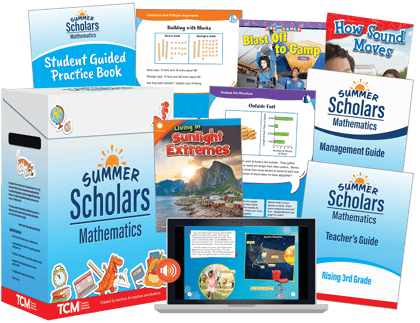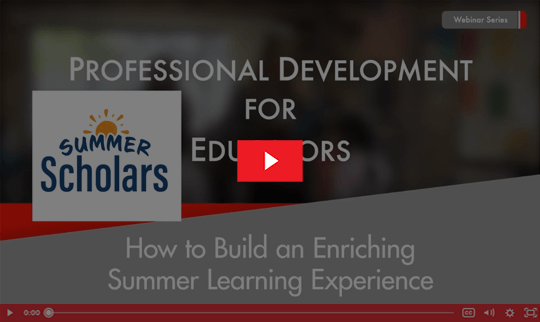5 Tips for Maximizing Your Summer Math Instruction
Summer school is an opportunity to present math content to students in a different way than they have experienced during the school year, even if your summer math curriculum is the same as what you are using during the school year. In this article, learn tips for maximizing summer math instruction to cultivate deep understanding for math mastery.
Take a Different Approach for Summer Math Instruction
Most of the students that fill your summer school classrooms have already seen, and seen again, the content that you are going to present. These students listened to their teacher share the content, then were pulled into a small group to walk through it again. Therefore, presenting the same content to your students, in the same way, is a disservice to them and a waste of time and summer sunshine. Teachers need to approach the content from a different direction, to take the time to cultivate the deep understanding needed to gain mastery in math.
Even if you use the same curriculum during the school year as in your summer math curriculum, you can enhance the lessons and put a fun spin on them. No matter what you do with a lesson, be sure to give students time to explore the content and a safe space to share their thinking.
This isn’t always easy in this time of acceleration and fast-paced gap closing. In this rush, however, we need to remember that there are some great ways to let students explore the content and develop their own understanding of the mathematics you will present in your summer math curriculum.
Summer school is a limited time to close the remaining gaps in your students’ knowledge. But this small window is a perfect time to slow down and revisit the practices that allow students to flourish in math class, with a few helpful tips for teachers.
Use the Concrete, Representational, Abstract (C-R-A) Instructional Sequence
Allow students to explore concepts and “see” the math first, using the Concrete, Representational, Abstract (C-R-A) Instructional Sequence.
As you start to plan your summer math curriculum, be sure you are considering how to reteach those focus standards by first starting with the use of manipulatives (concrete). Students need to move counters, to connect cubes, and to use number lines, so that they can gain a deeper understanding about what is really happening with the mathematics. 
Once they can “see” the math, give them paper and pencils to draw what they are seeing (representational). When students start to make those connections, your lesson can shift to using numbers and symbols.
Beans, notecards, rocks collected by students outside, cut up paper; basically, anything can be a math manipulative, so don’t let a lack of formal tools stop you. If you bring in baggies of grapes or candies, students can have edible manipulatives. Just remind them not to share.
Be sure to always keep manipulatives out. This reinforces the understanding that they are a tool to be used whenever students need them. The same applies to paper for drawing their work. Students are all on different paths to mastery and having all these items available reminds them that their journeys are equally valid.
Encourage Mathematical Discourse
Facilitate conversations that lead to deep understanding. Vygotsky’s Cognitive Development Theory asserts that cognitive abilities are socially constructed. Summer is a great time to allow math understanding to be developed socially. Give students a task to figure out with a partner, flip a lesson upside down, and start with the hardest problem first. Then have groups of two to three students talk about their solution paths.
Students do not have to solve the problem, but it gives them an experience to reference while learning the skill. This allows for productive struggle and the sharing of ideas and strategies among students. It also reduces teacher talking time and focuses the lesson on students.
Furthermore, when students are talking, it gives teachers a chance to hear their thinking. This allows for misconceptions to be addressed as soon as they are developed, instead of after they are practiced on paper.
Integrate Mathematics Readers and Challenges
Make real-world connections to your summer math curriculum by offering students math readers and challenges that engage them and expand their learning. Whether fiction or non-fiction, a good book can build a strong bridge to an otherwise inaccessible mathematical concept. Books build student interest and connect math to the real world. Adding books that include mathematics within the story allows students to think about different math skills and content in a non-threatening way.
When a book shares weird facts, students will be excited to try math because it will give them more information about the topic. For example, reading about edible bugs from The Hidden World of Edible Insects: Comparing Fractions makes working with fractions much more valuable.
In addition to books, incorporating STEAM challenges that explore topics in science, technology, engineering, arts, and mathematics invite students to collaborate with peers to creatively solve problems.
Giving students the room to author their own learning, having a clear and present voice in every lesson in your summer math curriculum, and making real-world connections to math skills brings deeper engagement.
Have Fun
In addition to the three researched-based strategies in this article, remember that summer should be fun. You want your summer math students to participate eagerly in summer learning, and to be engaged actively in this short learning opportunity. Make time to take your kids outside. Learn together about the summer sun while its rays are shining on your class. Bring fun into your classroom while you bring strong math conversations into the lessons in your summer math curriculum.
Choose the Right Summer Math Curriculum
An easy way to incorporate all these strategies into your summer lessons is by choosing a summer math curriculum that contains powerful approaches to summer learning.
 The Summer Scholars program incorporates some of TCM’s strongest elements combined with these strategies—a concrete, representational, abstract (C-R-A) instructional sequence, opportunities for mathematical discourse, and integrated mathematics readers and challenges—plus a healthy dose of fun. It’s built to support teachers and to engage students.
The Summer Scholars program incorporates some of TCM’s strongest elements combined with these strategies—a concrete, representational, abstract (C-R-A) instructional sequence, opportunities for mathematical discourse, and integrated mathematics readers and challenges—plus a healthy dose of fun. It’s built to support teachers and to engage students.
Make the most of your summer math curriculum by implementing strategies that allow students to explore the content and develop their own understanding of the mathematics. You can maximize your summer math instruction by allowing students to explore concepts and “see” the math first by facilitating conversations that lead to deep understanding and making real-world connections to mathematics. Choose a summer math curriculum that will help you implement these strategies and remember to have fun!
Author Bio:
View All AuthorsDanielle Battle, M.A., Academic Officer for Teacher Created Materials
Danielle currently serves as an Academic Officer for Teacher Created Materials, where she provides professional development and training on TCM curriculum materials and Shell Education professional resources for school districts, teachers, and school administrators. Dani has a passion for bringing joy back into the classroom for all students. She began her education career over twenty years ago as a teaching assistant. She then taught in pubic and charter schools in Baltimore and the District...
Join the TCM Blog Community
Subscribe by sharing your email address and we will share new posts, helpful resources and special offers on the issues and topics that matter to you and the children and teens you support.


